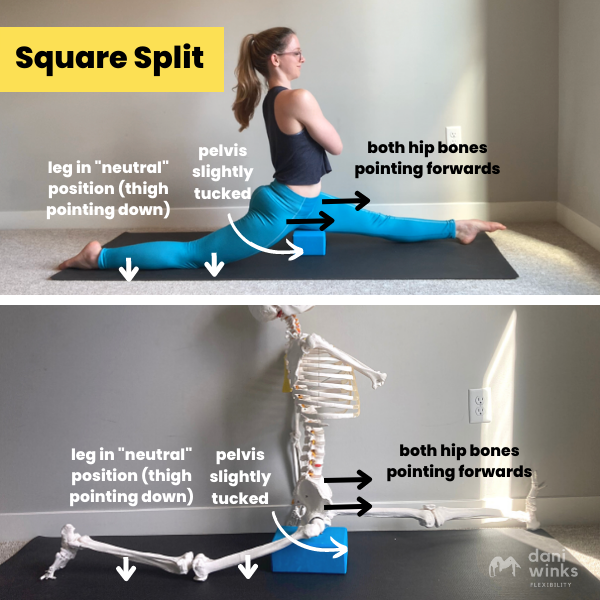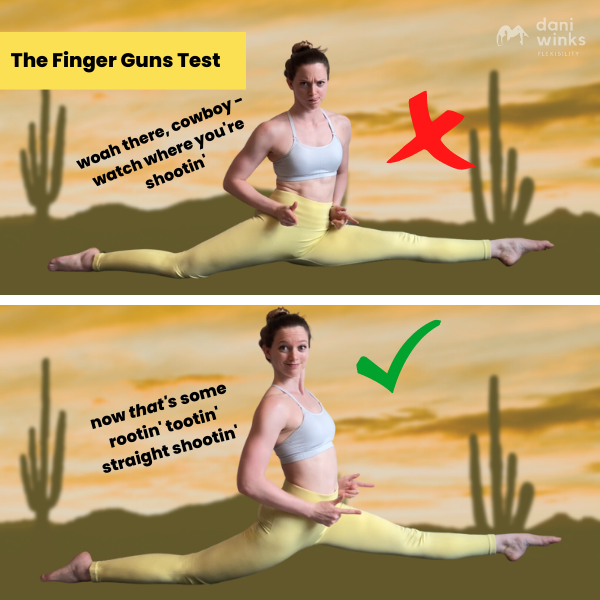How to Tell if Your Split is “Square” (the “Butt Cheek Test” and More!)
How to Tell if Your Split is “Square” (the “Butt Cheek Test” and More!)
Are you keeping your hips square when practicing front splits and lunges? Do you know how to tell? Here are some of the most common ways I like showing students you can check for yourself if your hips are properly “square.”
Why Do We Care About “Square” Splits?
Often when we talk about “square” when we’re stretching we’re referring to the position of our pelvis (our hip bones). In a front split, square hips refers to a neutral pelvic position where both hip bones are pointing forwards like headlights, and the top of the pelvis is close to parallel to the floor (technically we can’t have a totally neutral pelvis due to the limited amount our back leg can extend behind us before we need to tilt our pelvis forwards slightly - but for the sake of discussion, think of being able to keep the top of your pelvis as lifted as you can to avoid having to lean forwards). This requires a great deal of flexibility in our hip flexors in our back leg (psssst - need a review of what muscles are invovled in a front split? Check out last week’s blog post!)
Now there’s nothing wrong about “un-square” splits - in fact you’ll notice many dancers, circus artists, pole athletes, and more intentionally use “open” splits in performances because they can appear more flat with less effort. But there are several reasons square splits (and “keeping your hips square” in general) are often preferred in flexibility training
Here’s a simplified visual of what happens to our hip flexors (blue band) when we square and un-square our hips. Notice how the band tightens and gets more of a stretch in the “square” hip position, and gets a bit of slack in the “unsquare” position.
Keeping your hips square encourages more of a stretch in the hip flexors in the back leg - these are usually the muscles that are the tightest and the biggest challenge for people trying to flatten their splits
Keeping your hips square is more active - it requires more muscle engagement (especially in the glutes!) which helps our nervous system recognize that this is a “safe” position and allow us to stretch deeper
Square hips are a safer base for adding backbends to - it’s easier (and safer!) to add a backbend on top of a neutral base to avoid excessive twisting and imbalances. So if you have ambitions to work on backbend-y split-y shapes like dancer’s pose, needle scales, or even king pigeon - you’ll need to learn to do that in a square-hipped position
3 Tests for Square Hips in a Front Split
The Finger Guns Test
Alright-y cowpoke, time to restore some order to your front splits - no more Wild West hips that just do whatever they want! Slide out into your front split. Take your hands to your hip bones pointing your fingers out like finger guns in the direction your hips and torso are facing. If you’re shooting out slightly sideways, that means your hips aren’t quite square. Adjust your hips so that your finger guns can shoot true - straight toward that front foot!
Square hips = Finger guns pointing forwards (pew pew!)
The Butt Cheek Test
This is my favorite “test” because it’s the most obvious and we get to talk about butts. Win-win.
This one you’ll need to be able to see yourself in a mirror, or film yourself with your phone and watch the video
Slide out into a split with the outside of your front leg facing your mirror (or camera). That means you should be able to see your butt, not your crotch. How many butt cheeks do you see? Do you see two big scoops of booty? If you can see both butt cheeks, your hips are likely unsquare. Try to adjust your hips so both hip bones are pointing forwards - this will “hide” your far side butt cheek behind the one that’s closer to the mirror/camera.
Square hips = only one butt cheek visible
*Note: if you are particularly bodaciously endowed, your far-side butt cheek may still peek out a bit, that’s OK.
The Broomstick Test
For folks who like some physical and visual feedback, this can be a helpful test. You’ll want some kind of long straight rod, like a broomstick or long dowel.
Slide into your split. Take your broomstick and hold it across the front of your hips, trying to flatten it against the bony part of the front of each hip bone. Is your broom parallel to the front of your mat? Or is it slightly rotated out to the side? If it isn’t totally perpendicular to your front leg, your hips aren’t square.
Square hips = broom parallel to the front of your yoga mat (aka perpendicular to your front leg)
Trouble Keeping Your Hips Square?
Stay tuned for Wednesday’s post where I’ll offer my favorite sneaky drills for helping keep your hips square in your lunges and splits, as well as strengthening the muscles responsible for helping keeping your hips square unassisted.
Related Content
Related On-Demand Class
Related Blog Posts
How to Fake a Split: The “Illusion” Split - this is an example of an un-square split that’s very common in performances
Stubbornly Tight Hip Flexors? Quick Test for Femoral Nerve Tension
Best Practices for Flexibility Training - How to Maximize Progress








